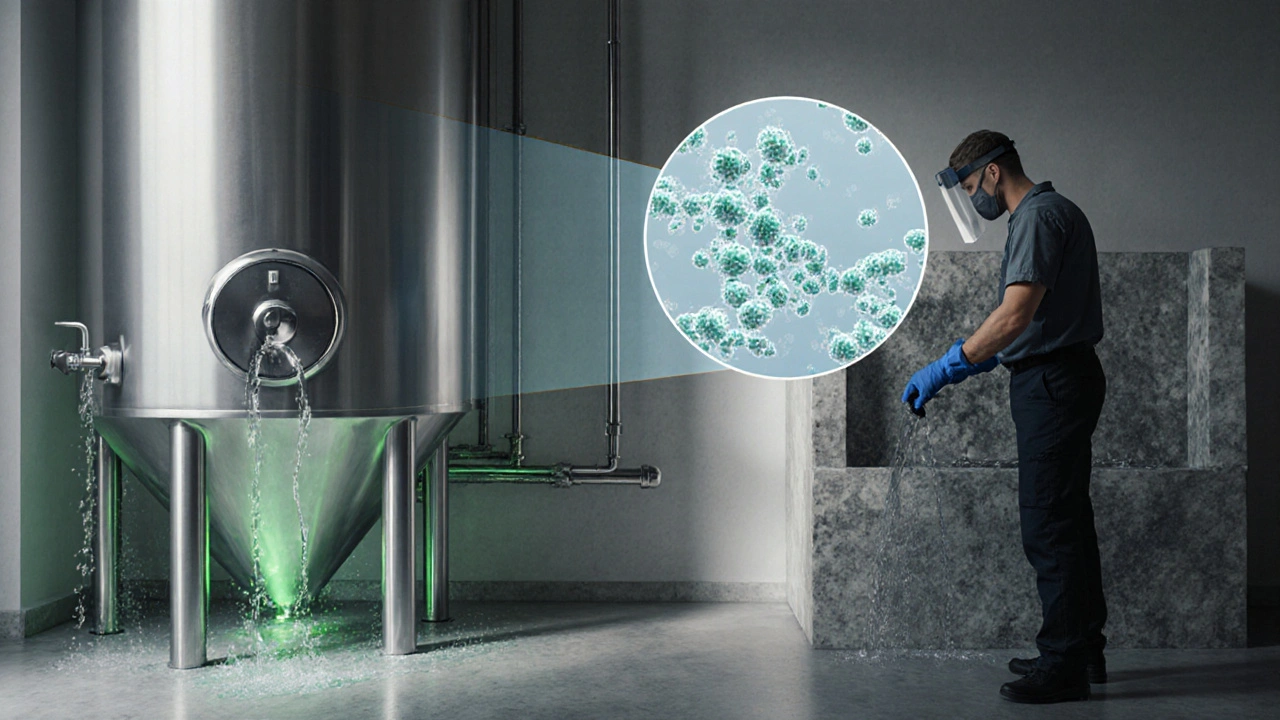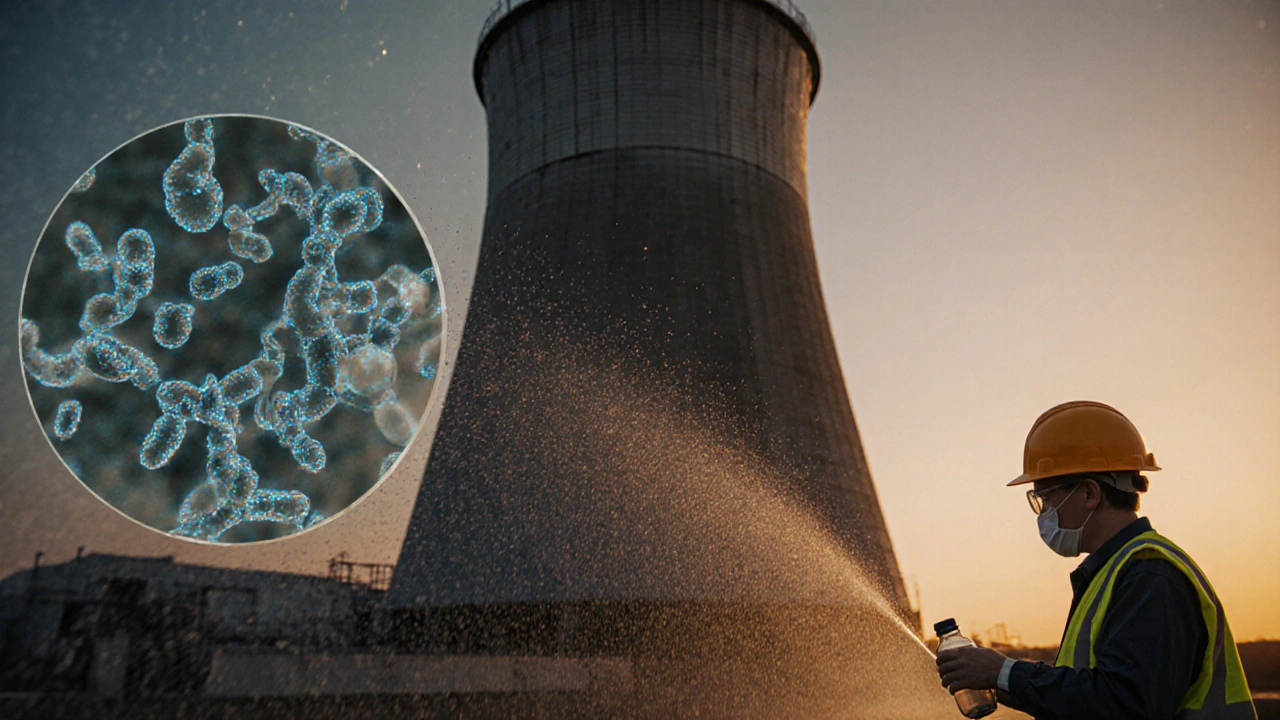Legionella Risk Assessment Calculator
This interactive tool estimates the risk of Legionella bacteria growth in water systems based on temperature and stagnation time.
When you turn on a tap, take a shower, or admire a sparkling fountain, you probably don’t think about the hidden microbes that could be lurking inside the water. One of the most notorious culprits is the bacterium that causes Legionnaire's disease. Understanding how everyday water systems become breeding grounds helps protect families, hotels, hospitals, and anyone who breathes in aerosolised water droplets.
What Is Legionnaire's Disease?
Legionnaire's disease is a severe form of pneumonia caused by inhaling Legionella bacteria. First identified after a 1976 outbreak at an American Legion convention, the disease can lead to fever, cough, muscle aches, and, in vulnerable people, death. It’s not spread person‑to‑person; the pathogen lives in water and becomes a problem when water is misted or splashed, creating an aerosol that carries the bacteria straight to the lungs.
Why Water Systems Are Perfect Hosts
Legionella thrives in warm, stagnant water-think 20‑50°C (68‑122°F). Several common water systems provide exactly that environment:
- Cooling towers circulate water to dissipate heat from industrial HVAC units. They often run continuously, allowing biofilm to form on internal surfaces.
- Hot water tanks in residential and commercial buildings keep water at temperatures ideal for bacterial growth if temperature controls fail.
- Decorative fountains and water features create visually appealing mist but also disperse tiny droplets into surrounding air.
- Compact shower heads and plumbing fixtures can develop dead‑ends where water stagnates.
When any of these systems produce an aerosol-whether from a vent, a spray nozzle, or a shower-the Legionella bacteria hitch a ride straight to the lungs of nearby occupants.
High‑Risk Settings and Real‑World Outbreaks
Outbreaks tend to cluster where vulnerable populations live or work and where water systems are complex:
- Hospitals often have elaborate hot‑water loops, and patients may be immunocompromised, making them prime targets.
- Hotels serve travelers from around the globe; a single contaminated shower can affect dozens of guests.
- Large office buildings with central air‑conditioning frequently use cooling towers, and office workers spend long hours in the same environment.
- Senior living facilities combine high‑risk residents with extensive water infrastructure, a lethal mix if not managed.
One infamous case in 2015 involved a New Zealand hotel where a faulty hot‑water system led to 13 confirmed cases of Legionnaire's disease. The investigation traced the bacteria to a biofilm‑laden tank that hadn’t been flushed in months. After a comprehensive cleaning and temperature reset, the outbreak stopped.

Detection: Testing Water Before It Becomes a Threat
Regular monitoring is the only reliable way to catch Legionella early. Two main testing methods dominate the field:
- Culture testing - water samples are plated on selective media; colonies appear after 7‑10 days. It’s the gold standard but slow.
- Polymerase chain reaction (PCR) - detects bacterial DNA within hours, giving a rapid snapshot of contamination levels.
Both approaches have pros and cons, so many facilities use them in tandem. Results are reported as colony‑forming units (CFU) per millilitre; public health guidelines often set a threshold of<10CFU/mL for safe operation.
Prevention Checklist: Keeping Your Water Clean and Safe
| Action | Why It Matters | How Often |
|---|---|---|
| Maintain hot‑water temperature≥60°C (140°F) | Stops bacterial growth | Continuous |
| Flush low‑use outlets weekly | Prevents stagnation | Weekly |
| Clean and disinfect cooling towers | Removes biofilm | Quarterly |
| Conduct Legionella testing (culture or PCR) | Detects contamination early | Quarterly or after repairs |
| Install point‑of‑use filters where aerosols are generated | Captures bacteria before inhalation | Inspect monthly |
Implementing these steps creates multiple layers of defence, often called a “water safety plan.” Even if one layer slips, the others keep the risk low.
If You Suspect an Outbreak, Act Fast
- Notify local health authorities immediately - they can deploy rapid testing teams.
- Shut down or isolate the suspected water source (e.g., turn off a cooling tower).
- Provide medical evaluation for anyone showing flu‑like symptoms, especially if they’ve been in the building.
- Initiate hyper‑chlorination or thermal shock (raising water temperature to>70°C) to kill the bacteria.
- Document every action and keep records for future audits.
Quick response limits the number of cases and helps protect the broader community.
Frequently Asked Questions
How is Legionella different from regular pneumonia?
Legionella causes a specific type of pneumonia that often requires a longer hospital stay and is treated with antibiotics like levofloxacin, whereas typical bacterial pneumonia may respond to a broader range of drugs.
Can home showers spread Legionella?
Yes, if the hot‑water tank is set below 50°C (122°F) and the shower isn’t used frequently, bacteria can multiply and become aerosolised when the tap is turned on.
What temperature kills Legionella?
Sustaining water at≥70°C (158°F) for at least ten minutes, known as a thermal shock, is effective at destroying Legionella colonies.
Are water filters a reliable solution?
High‑efficiency point‑of‑use filters (0.2µm) can capture Legionella, but they must be replaced regularly; otherwise they become a breeding ground themselves.
Who is most at risk?
Older adults, smokers, people with chronic lung disease, and anyone with a weakened immune system face the highest risk of severe disease.
Staying informed and proactive about water safety reduces the odds of a Legionella surprise. Whether you manage a building, run a hotel, or simply maintain your own home, these steps keep the invisible threat at bay.


Aman Vaid
September 30, 2025 AT 12:36Legionella thrives in the temperature sweet spot of 20‑50°C, a range that many building managers overlook when setting their hot‑water thermostats.
When water stagnates for more than two days, biofilm formation provides a protective niche for the bacteria.
Biofilm is essentially a slimy matrix that shields microbes from disinfectants, making routine flushing essential.
Thermal shock-raising water temperature to at least 70°C for ten minutes-effectively eradicates entrenched colonies.
However, many facilities rely on point‑of‑use filters, which, if not replaced regularly, become reservoirs themselves.
Culture testing remains the gold standard despite its week‑long turnaround, whereas PCR offers rapid detection but may over‑estimate viable organisms.
Regulatory guidelines often set a threshold of 10,000 CFU/L, yet outbreaks have occurred at much lower concentrations, highlighting the need for risk‑based approaches.
Cooling towers are notorious for aerosolizing Legionella; proper biocide dosing and regular cleaning are non‑negotiable.
Hospitals must prioritize hot‑water loop maintenance because immunocompromised patients are especially vulnerable.
Hotels, with their high turnover of guests, should incorporate Legionella risk assessments into their HACCP plans.
Senior living facilities combine high‑risk populations with extensive plumbing, creating a perfect storm if maintenance lapses.
The interactive risk calculator embedded in the article can guide facility managers in estimating exposure based on temperature and stagnation time.
Yet, the calculator’s binary output oversimplifies complex dynamics like water velocity and pipe material.
In practice, a multi‑point monitoring strategy-combining temperature logs, periodic sampling, and visual inspections-offers the most robust defense.
Ultimately, proactive stewardship of water systems, rather than reactive crisis management, is the cornerstone of Legionella prevention.
KayLee Voir
October 6, 2025 AT 23:05That risk calculator is a handy starting point, especially for smaller facilities that lack dedicated engineering staff.
Just remember to pair it with regular temperature checks and occasional water sampling to keep the data reliable.
Staying ahead of potential growth periods can save both health and reputation down the line.
Andrew Irwin
October 13, 2025 AT 09:34Implementing a simple weekly flush of seldom‑used outlets can dramatically cut stagnation time.
It's an easy habit that doesn't require expensive equipment.
Consistency is key.
Jen R
October 19, 2025 AT 20:03The article reads like a checklist without depth.
Joseph Kloss
October 26, 2025 AT 05:32While the piece outlines basic controls, it glosses over the philosophical paradox of controlling a living organism with mechanical means.
Legionella, after all, adapts to our interventions, finding niches where we think we’ve sealed them.
This cat‑and‑mouse game raises the question of whether true eradication is ever feasible.
Our overreliance on temperature thresholds ignores the microbial resilience embedded in biofilms.
Perhaps a more nuanced approach-integrating ecological insight with engineering-would serve us better than blunt force.
Anna Cappelletti
November 1, 2025 AT 16:01Great summary! Just a tiny note: the term “CFU per millilitre” should be written with a space before “per” for proper scientific style.
Also, remember to document each thermal shock in your maintenance log; auditors love a paper trail.
Keep up the good work, and don’t forget to celebrate those small wins in keeping water safe.
Dylan Mitchell
November 8, 2025 AT 02:30Wow, this post is a drama of bacteria vs. boilers!
But seriously, “biofilm” is spelled correctly, not “bio‑film”.
Watch the commas – “Legionella can thrive under these conditions, immediate action is recommended.” needs a period before “Immediate”.
Little grammar tweaks make a big difference.
Elle Trent
November 14, 2025 AT 12:59From a systems‑engineering perspective, the discussion feels surface‑level and lacks integration of risk‑based optimization algorithms.
Moreover, the jargon about CFU thresholds could be bolstered with statistical confidence intervals.
Overall, the piece needs deeper technical rigor.
Jay Ram
November 20, 2025 AT 23:28Keeping water warm and moving is the low‑effort hack we all need.
Even a modest 5‑minute weekly run‑through can prevent nasty surprises.
Think of it as a quick cardio session for your pipes.
Stay motivated and keep those systems healthy!
Elizabeth Nicole
November 27, 2025 AT 09:57Did you know that a single stagnant faucet can harbor enough Legionella to infect several people?
That’s why regular flushing isn’t just a recommendation-it’s a necessity.
Make a habit of turning on every tap for at least a minute each week.
It only takes a minute but saves lives.
Stay curious and keep those water lines active!
Dany Devos
December 3, 2025 AT 20:26The author presents a competent overview, yet the omission of legislative references detracts from its completeness.
In jurisdictions such as the EU, specific directives mandate regular testing.
Inclusion of such statutory frameworks would enhance practical applicability.
Aman Deep
December 10, 2025 AT 06:55🌊 Water is life, but hidden microbes can turn it into a silent threat!
Imagine a warm tropical pool where microbes throw a party-yikes!
Keeping temps high and flow swift is the secret sauce.
Stay safe and keep those taps sparkling! 😎
Marcus Edström
December 16, 2025 AT 17:24Collaboratively, we should develop a shared maintenance calendar across facilities.
This will ensure no system slips through the cracks.
Let’s unite our efforts for public health.
kevin muhekyi
December 23, 2025 AT 03:53I’ve seen buildings where neglect leads to outbreaks; it’s a stark reminder that vigilance pays off.
Simple checks can prevent costly crises.
lalitha vadlamani
December 29, 2025 AT 14:21From an ethical standpoint, neglecting water safety is indefensible.
Stakeholders have a moral duty to protect vulnerable populations from preventable disease.
Adherence to rigorous protocols is not optional but a solemn obligation.
We must hold ourselves accountable.